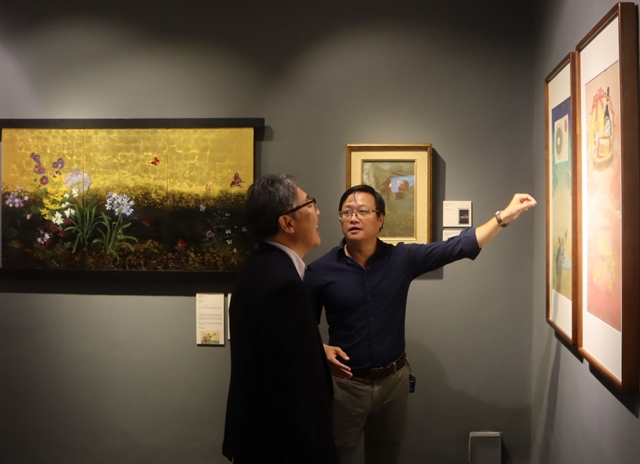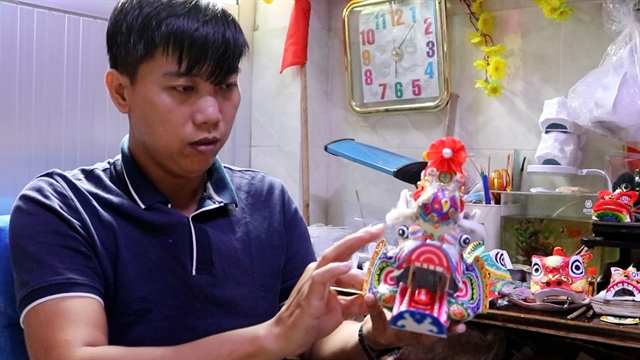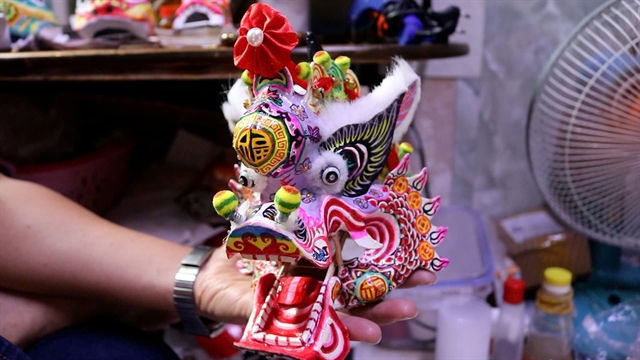 Life & Style
Life & Style

By Gia Linh
Vietnamese culture is undeniably a great source of inspiration for many arts and crafts, and it is getting more vibrant by accepting new concepts and ideas. As the culture expands, new crafts emerge.
Just like other craftsmen drawing ideas from the tradition, Vương Giai Huân, a native of HCM City, has been creating toy kylin heads and other mythical animals, taking inspiration from the much-loved kylin-lion-dragon dancing.
 |
| Vương Giai Huân of HCM City makes toy kylin heads and other mythical animals inspired by the popular art of kylin-lion dance. — VNS Photo Hồng Linh |
Huân’s house in District 11 has been his creative cradle for years. The place is packed with craft materials. Toy kylin heads of various sizes are displayed in glass cabinets, some adorn walls.
A toy kylin head looks just like its larger version with a moveable mouth and eyes, intricate hand-painted patterns and glittering jewellery.
His passion for this craft began long ago when he was very young and accompanied his father to working in kylin-lion dance troupes.
“My kylin-lion dance master taught me how to make large paper and bamboo lion heads, and I used to make a living out of it. But I quit as the craft became obsolete due to industrial production,” said the 39-year-old man.
He went on to other jobs, but became unemployed when the COVID-19 pandemic hit. He was scrolling through Facebook one day when he came across pictures of toy kylin-lion heads.
With his passion still burning, he started researching, made a few prototypes and posted them on Facebook.
“My creations back then were loved not only by Vietnamese but also foreign customers; many people asked to buy them. I received a significant number of orders, and my business has grown since.
“People use these toy kylin heads as decorations on their table, put them on the wall or in their cars in the hope they will bring prosperity and fortune.”
 |
| Kylin head is a symbol of luck and prosperity. — VNS Photo Hồng Linh |
Huân’s products show intricacy and meticulousness of craftsmanship in each curve and colour. Each is a one-of-a-kind because every pattern, eye, mouth, and other details are completely handcrafted.
He starts by making “the bones” or the frame from electric wire, and then adds layers of paper to form the flesh of the kylin-lion head.
He uses different types of paper since the surface needs to be elastic, soft and smooth. With the wrong type of paper the creases will easily tear apart, and details like eye-sockets can be hard to shape, he says.
For the hand-painted patterns, the artist takes ideas from his past days working at the kylin-lion dance team and products he sees online. The paints are mixed with a special liquid in an exact ratio to make them last longer.
Other parts, such as the eyes, whiskers and mouth, are created from random things Huân finds around him, such as colour buttons and beads.
He says making toy paper kylin heads is harder than large ones for dance teams, and so there are very few people in the business.
“It is hard to find suitable materials to make all the details look harmonious.
“You can buy readymade parts like eyes and jewellery for large lion heads, but for mini ones you have to craft them yourself.”
Besides kylins, the man also makes the heads of the rabbit, tiger and dragon. Depending on its size and complexity, he sells an item for VNĐ100,000 to one million ($4-40).
 |
| The craft requires Huân to be extremely meticulous and creative, especially when making intricate details. — VNS Photo Hồng Linh |
Making toy kylin heads is now Huân's main source of income, and it is also a means for him to spread Vietnamese culture and help preserve this traditional craft.
For over a year now he has been running workshops to teach people how to make toy animal heads, and they have become popular among both local residents and tourists alike. There are also classes for children.
Lê Hà Đăng Thanh, 8, says she and her friends get to be creative and learn a wonderful craft by attending the class.
“Teacher Huân is really attentive when teaching us. I am happy that I can learn how to use watercolour and make creatures such as the lion head and the Earth God," she says.
Huân takes pride in his workshops, saying it feels great to be able to take this traditional craft to young people and help preserve and innovate the tradition with a unique twist.
“I hope to find those with the similar passion as me, and I hope to grow my business further." — VNS




